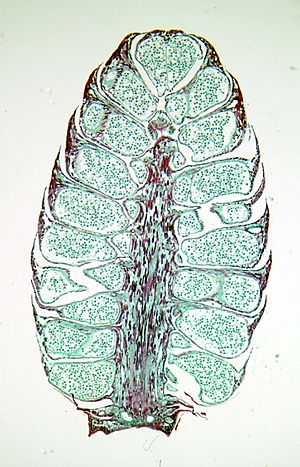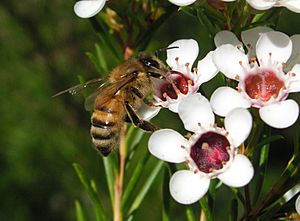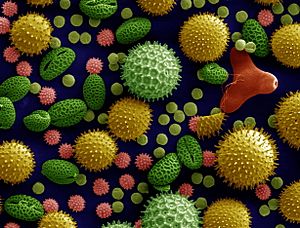Pollen facts for kids

Pollen is a fine, powdery substance made of tiny grains. These grains contain the male cells (like sperm) that plants use to make new seeds. Think of pollen grains as tiny plant "seeds" that carry the male part needed for plant reproduction. They are very important for how plants make more of themselves!
Contents
Pollen in Flowering Plants
How Pollen Grains Are Made
Inside a flower, there's a part called the anther. The anther is like a small factory that makes pollen. Inside the anther, special cells divide and change to become pollen grains. Each pollen grain holds the male parts needed for the plant to reproduce.
Once the pollen is ready, the anther opens up and releases it. This pollen then needs to travel to another part of the flower, called the carpel, or to another flower entirely.
How Pollination Works

Pollination is the process where pollen moves from one part of a flower to another, or from one flower to another. There are two main ways this happens:
- Self-pollination: This is when pollen from a flower lands on the female part (the pistil) of the same flower or another flower on the same plant. It's like a plant pollinating itself.
- Cross-pollination: This is when pollen from one plant travels to the pistil of a different plant. Most plants use this method because it helps them create stronger, more diverse offspring. Since plants can't move, they need help to move their pollen around.
How Wind Helps Pollen Travel
The wind is a big helper for many plants. Some plants make very light pollen. The wind can easily pick up this pollen and carry it far away. It might blow from one plant's flowers to another plant's sticky pistil. This is why you might see a yellow dust on cars or surfaces during certain times of the year – that's often pollen carried by the wind!
How Animals Help Pollen Travel
Animals are also amazing helpers for plants. Many flowers are bright and colorful, and they have a sweet smell to attract animals. These flowers also make a sugary liquid called nectar.
Imagine a bee flying by. It sees or smells a beautiful flower and lands on it to drink the nectar. While the bee is drinking, tiny pollen grains stick to its body. Then, when the bee flies to another flower, some of that pollen brushes off onto the new flower's pistil. The bee gets a tasty snack, and the plant gets its pollen moved! Bees even use pollen as protein to feed their baby bees (larvae).
This teamwork between plants and animals is a special kind of relationship called mutualism. Both the plant and the animal help each other, and they have evolved together over a very long time.
Pollen Allergies
Sometimes, pollen can cause problems for people. If you get a runny nose, sneezing, and itchy eyes when certain plants are releasing pollen, you might have a pollen allergy. This is often called hay fever or pollinosis.
Pollen that causes allergies usually comes from plants that use the wind to spread their pollen. These plants make a lot of very light pollen. Since the wind blows it everywhere, it's easy for people to breathe it in. When this pollen gets into your nose, it can make you feel sick, like you have a cold that just won't go away.
Pollen allergies are more common in places with seasons, like cold or mild climates. This is because pollen production changes with the seasons. In warmer, tropical places, pollen is made more evenly throughout the year, so allergies might be less seasonal.
If you think you have a pollen allergy, it's a good idea to see a doctor. They can help you figure out what's causing your symptoms and suggest ways to feel better. The best way to avoid a pollen allergy is to try and avoid contact with the pollen itself, especially on high pollen count days.
Images for kids
-
A tulip anther covered in many pollen grains.
-
A European honey bee carrying pollen in a special "basket" on its leg back to its hive.
-
A Diadasia bee visiting a yellow Opuntia engelmannii cactus flower.
See also
 In Spanish: Polen para niños
In Spanish: Polen para niños












